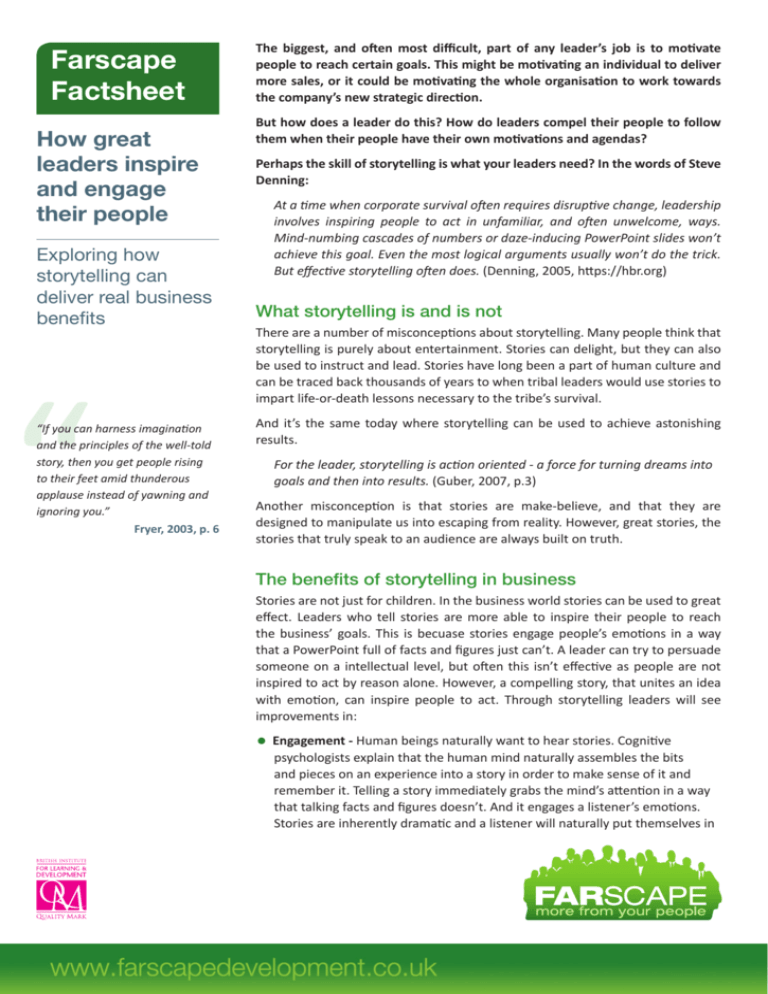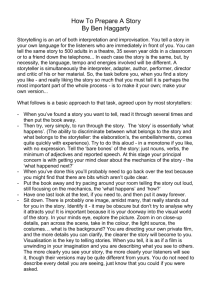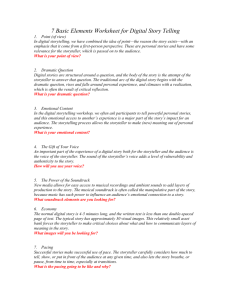How leaders inspire and engage their people-1
advertisement

Farscape Factsheet How great leaders inspire and engage their people Exploring how storytelling can deliver real business benefits “If you can harness imagination and the principles of the well-told story, then you get people rising to their feet amid thunderous applause instead of yawning and ignoring you.” Fryer, 2003, p. 6 The biggest, and often most difficult, part of any leader’s job is to motivate people to reach certain goals. This might be motivating an individual to deliver more sales, or it could be motivating the whole organisation to work towards the company’s new strategic direction. But how does a leader do this? How do leaders compel their people to follow them when their people have their own motivations and agendas? Perhaps the skill of storytelling is what your leaders need? In the words of Steve Denning: At a time when corporate survival often requires disruptive change, leadership involves inspiring people to act in unfamiliar, and often unwelcome, ways. Mind-numbing cascades of numbers or daze-inducing PowerPoint slides won’t achieve this goal. Even the most logical arguments usually won’t do the trick. But effective storytelling often does. (Denning, 2005, https://hbr.org) What storytelling is and is not There are a number of misconceptions about storytelling. Many people think that storytelling is purely about entertainment. Stories can delight, but they can also be used to instruct and lead. Stories have long been a part of human culture and can be traced back thousands of years to when tribal leaders would use stories to impart life-or-death lessons necessary to the tribe’s survival. And it’s the same today where storytelling can be used to achieve astonishing results. For the leader, storytelling is action oriented - a force for turning dreams into goals and then into results. (Guber, 2007, p.3) Another misconception is that stories are make-believe, and that they are designed to manipulate us into escaping from reality. However, great stories, the stories that truly speak to an audience are always built on truth. The benefits of storytelling in business Stories are not just for children. In the business world stories can be used to great effect. Leaders who tell stories are more able to inspire their people to reach the business’ goals. This is becuase stories engage people’s emotions in a way that a PowerPoint full of facts and figures just can’t. A leader can try to persuade someone on a intellectual level, but often this isn’t effective as people are not inspired to act by reason alone. However, a compelling story, that unites an idea with emotion, can inspire people to act. Through storytelling leaders will see improvements in: • Engagement - Human beings naturally want to hear stories. Cognitive psychologists explain that the human mind naturally assembles the bits and pieces on an experience into a story in order to make sense of it and remember it. Telling a story immediately grabs the mind’s attention in a way that talking facts and figures doesn’t. And it engages a listener’s emotions. Stories are inherently dramatic and a listener will naturally put themselves in “Seldom is a good story so needed, though, as when a major change of professional direction is under way - when we are leaving A without yet having left it and moving toward B without yet having gotten there. In a time of such unsettling transition, telling a compelling story...inspires belief in our motives, character, and capacity to reach the goals we’ve set.” Ibarra and Lineback, 2005, p.66 the place of the protagonist. This means that people will be far more engaged in, and therefore far more likely to remember, a story compared to a list of facts and figures. • Trust - In order to engage people’s emotions, a storyteller must show their own emotion. This involves being vulnerable - laying bare hopes and dreams, potentially failures along the way in the struggle to reach the story’s conclusion. And if a leader can be open and vulnerable, their people will be far more likely to trust them. • Willingness - People have their own set of authorities, statistics and experiences. Trying to persuade people to act based on your statistics and quotes from authorities, results in an internal argument for the listener. If a story is compelling, if people understand why they are heading towards a goal, and have shared in the emotional journey with the teller, they will be far more willing to work towards that goal. • Action - And if people are more willing to work towards a goal, you will see more action, more productivity and people pulling in the right direction more often. How to tell compelling stories • Be honest - A good storyteller must be authentic. If they are to inspire trust Conclusion It is the job of any leader to inspire their people and to ensure that they are all pulling in the right direction. This requires persuasion. Often leaders try to persuade through reciting the facts and figures and through telling people what needs to be done. But this is not inspiring, and it doesn’t change how people feel about a situation. One way to ensure that leaders engage people’s emotions is to tell stories. A well-told story has the power to turn goals into action and to make people want to deliver those goals. in their people, and to have them feel what they feel, then people need to see that the teller is being honest. This involves a leader showing and sharing their emotions. This can be a challenge - it requires being vulnerable, something that leaders are often not comfortable with. • Tailor to the audience - A good storyteller knows what their audience knows about, cares about and wants to hear. That way the storyteller can fulfill a listener’s expectations and take them on a satisfying emotional journey. This way the audience stays engaged with the story. • Be relevent - “A great storyteller never tells a story the same way twice. Instead she see what is unique in each storytelling experience and responds fully to what is demanded.” (Guber, 2007, p. 5) Stories should always be tailored to the situation. This requires the ability to be flexible and able to improvise when necessary. • Believe in the goal - A storyteller must use their story to capture the mission in a way that evokes powerful emotions and wins the support of the audience. To do this they must exude passion for achieving the goal. To win the trust and support of the audience, the storyteller must truly believe in their mission. References Denning, S. (2005) Telling Tales. Harvard Business Review Fryer, B. (2003) Storytelling That Moves People. Harvard Business Review For more Farscape Factsheets click here. Guber, P. (2007) The Four Truths of the Storyteller. Harvard Business Review Ibarra, H. and Lineback, K. (2005) What’s Your Story? Harvard Business Review







